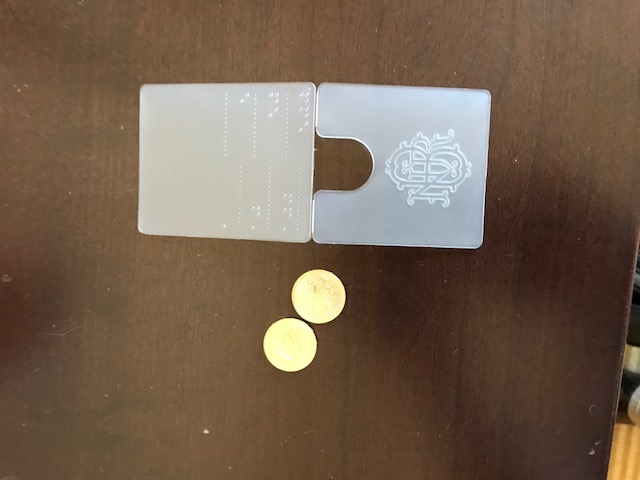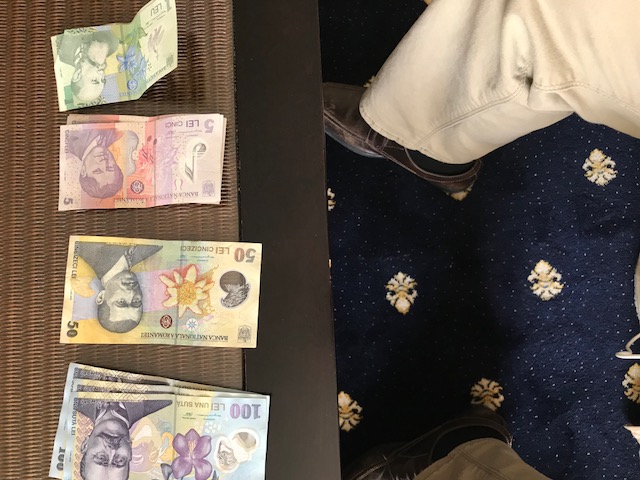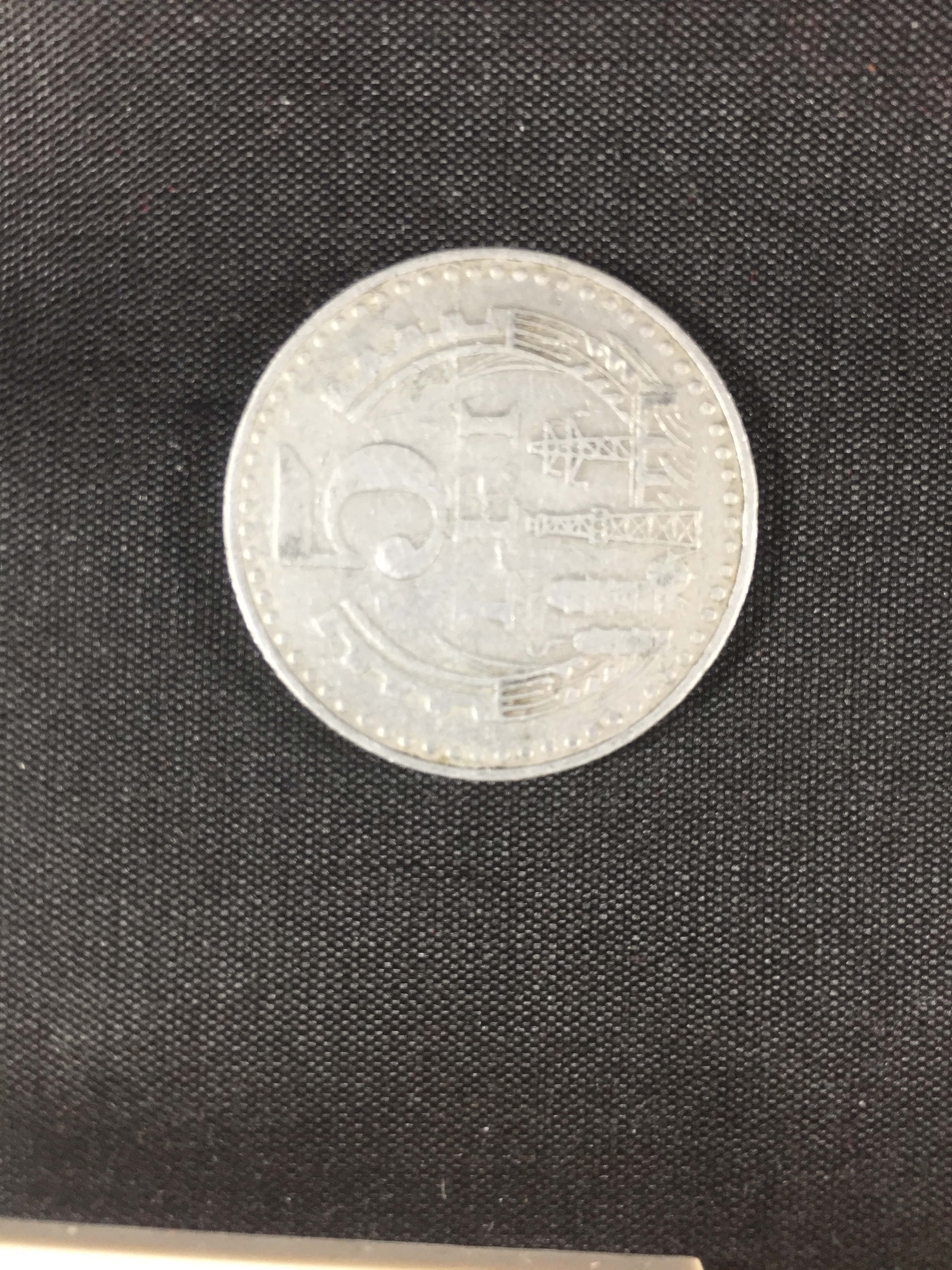Sitting in a hotel room in Bucharest, with so much information in my head after the visit to the Museum of the National Bank of Romania. It is too late now to do anything, late even for a meal or a drink, but I definitely want to dump my brain hoping to capture as much as possible from what I heard today.
It started as always, when I found out I would be working in Romania, I wrote to the museum of the National Bank, and Oana Sticlaru immediately got back to me and scheduled a meeting for me.
I was a bit late, as it was quite difficult to find a taxi which would be willing to take me and Baldwin, so finally a gentleman who worked at the Avis desk at the hotel gave me a ride. Yes, this is an advertisement, of course, they deserve it. Without Avis, I wouldn’t have made it to the museum.
Mihai Vasile met me at the entrance and led me to a large hall where some of his colleagues met me from the museum. This hall earlier was used for bank transactions before. The room on purpose was designed to have bad acoustics in order for people not to be heard easily. Mihai had a number of things lined up to show me. Here I also met Oana Sticlaru who organized my visit.
It was evident immediately that Mihai really cares for the collection, he showed everything to me with so much enthusiasm. I don’t even know how they can work with a coin collection, when for employees of the museum a private collection is not allowed. This is not the first place I have heard this. But I guess, the advantage is that they can work with a collection larger than one person could ever put together.
Once again, it was a great idea to ask about local coins. Sure, somebody who cares about numismatics can give you a good overview of anything, but there is just something special about people telling me about their own coins, their own history and culture. It was just an icing on the cake that Mihai speaks English exceptionally well. It really impressed me that I didn’t have to learn how to say “I don’t understand” in Romanian. Throughout my stay, I could always find a language to communicate with all people.
So, we started at the very beginning of money in the region of today’s Romania. Over 2000 years ago arrow heads, and small metal bows with arrows were used as currency.
The next object he showed me was the first coin made on the grounds of Romania from about 200 BC. We looked at a couple of coins of Trajan which showed evidence of Trajan as an emperor of Germania and Romania, the script of the coin says: “Germanicus Dacicus”.
After a few more Roman coins, he showed me the first Romanian coin, minted by Vladislav I from approximately 1365.
I learned that the name of Leu, and also of Leva originates from the Dutch Loewenthaler, the meaning is lion, which can be seen on the Loewenthaler as well.
Finally, we went through the history of Leu, starting with an old Bani from the 1860’s minted by Carol I who also minted the first 20 Lei gold coins, but the first mintage was discontinued as he printed King of the Romanians which was opposed by the Habsburgs, so later this 20 Lei piece was circulated with the script “King of Romania”.
It was also interesting to see how coins evolved over the years of Kingdom and later communism.
We finished with three 50 Bani coins, one original, and two commemoratives, which are the most recent coins and I received them as a gift, together with a plastic sheet showing the denominations of currencies with braille written on it that can be used to measure paper bills.

I also learned some about contemporary bills that they are made of plastic, which makes them about 8 times as durable as other paper notes. The technique was first used in Australia and later transferred to Romania by employees of the Australian mint.

After the introduction to Romanian coins, Mihai told me some about the building where the bank is Located, which is inside two palaces built together, one is an older, and the other is a newer one.
I was glad to hear that the museum also created a section for kids, hoping that when numismatists come to visit, it would give some entertainment for their kids. Great idea, I wish more places had the same.
Speaking of numismatists, there are a few hundred serious ones in Romania, they also have a periodical. There are also other numismatic collections, at the Romanian National Academy and at the History Museum, but the National Bank has the largest collection, counting about 30000 pieces.
Before this trip, I spent some time to read about Romanian money. I have to admit, I didn’t become an expert, but I put more effort into it than usual, as I wrote about it, many times I felt sorry I didn’t spend much time before the trip to learn enough about the history of local currency. However, I did learn many things which I would not be able to find anywhere else other than in the museum. In a way Romanian coins are very special to me, as a 5 Lei con was the first in my collection. At that time when I had this coin from my uncle’s trip, I didn’t know I was collecting. But when I started collecting a couple of years later, I remembered this coin and added it to my collection.

Besides numismatics, I have to mention that I had a great time in Romania. In some countries, it is very difficult to find local food. It seemed to me that Romanians are proud of their language, culture and food of course, and they want to show it to you. I had some really fine national dishes, drinks and sampler platters. That’s all I can do when time is limited and I want to make the most of it. I spent less than four days in the country, and most of it was work. I hope you see the pattern here, I finished my last trip with food. For that matter, I think my last four posts have a mention of food. I love eating and exploring. And if I really want to connect it to blindness, it is one of the easiest things to organize when going to an unknown place, to find some good food. It doesn’t require vision to plan it out, usually I can get to a restaurant independently, and besides coins, food is one of the best ways of connecting with a new city or a country. Of course, in the context of this blog, I don’t discuss it in greater detail, and it is certainly not interesting enough for anybody else to write about it, but I have great memories related to food during my travel.
So, a big thanks to all who helped me to have such a great time, especially Oana and Mihai, and all my colleagues who helped me navigate the food scene so this time I didn’t need to plan.
I’m off to Slovakia tomorrow, where of course, another museum is lined up. Come back and read about it.

